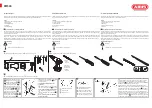
8699134
PLASTIC WELDING KIT
V1.0
8
For technical questions call 1-800-665-8685
5. Perform the following actions at the same time to add
plastic to the damaged area:
5.1 Press down on the damaged area so the welding head
is flat against the workpiece. Slowly draw the soldering
iron across the crack.
5.2 Apply pressure and feed the plastic welding rod
through the welding head opening.
6. Remove the plastic welding rod from the welding head. Should
an area require more plastic, reinsert the rod and repeat step 5
until you’ve added as much plastic as you desire.
7. Use the hot welding head to smooth and blend the plastic
into the workpiece.
8. Shut the butane soldering iron off and place the butt end
into the support slot (9) to allow to cool. Clean the welding
head with the brush (5) and cleaning rod (6) once it is cool
enough to touch.
9. The workpiece is ready for sanding to smooth the surface.
REPAIRING A LARGE HOLE OR CRACK
A hole or crack may be too wide to repair in a single pass.
Cover the gap with wire mesh.
1. Cut a strip of reinforcing mesh (7) to cover a gaping crack
or a hole. The mesh should rest below the workpiece’s
surface. The melted plastic will cover it and allow sanding
without exposing the mesh.
1.1 Apply the mesh to a curve to provide structural
support when soldering.
2. Tack the mesh to one end of the damaged area. Heat up
the area until you can press the mesh into the plastic.
Smooth the plastic over with the welding head.
2.1 You may need to tack more than one spot.
3. Follow the instructions for filling a crack. Press the rod
material hard enough so it will pass through the mesh to
cover the other side.









































